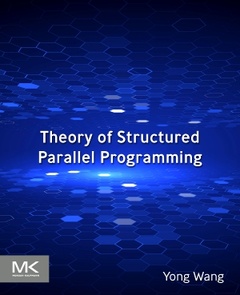Theory of Structured Parallel Programming
Langue : Anglais

Theory of Structured Parallel Programming is a comprehensive guide to structured parallel programming corresponding to traditional structured sequential programming. The book provides readers with comprehensive coverage of theoretical foundations of structured parallel programming, including analyses of parallelism and concurrency, truly concurrent process algebras, building block-based structured parallel programming, modelling and verification of parallel programming language, modelling and verification of parallel programming patterns, as well as modelling and verification of distributed systems. Parallel programming has a relatively long research history. There have been always two ways to approach parallel computing: one is the structured way, and the other is the graph-based (true concurrent) way. The structured way is often based on the interleaving semantics, such as process algebra CCS. Since the parallelism in interleaving semantics is not a fundamental computational pattern (the parallel operator can be replaced by alternative composition and sequential composition), the parallel operator often does not occur as an explicit operator, such as in the mainstream programming languages C, C++, Java, et al. Traditional structured programming had great success in sequential computation. On the other hand, current structured parallel programming has focused on parallel patterns (also known as parallel skeletons, templates, archetypes), and, in comparison to structured sequential programming, the corresponding structured parallel programming with solid foundation still has been missing. Theory of Structured Parallel Programming provides readers with the theoretical foundation for understanding and applying structured parallel programming techniques to current hardware such as multi-cores, multi-processors, and GPUs, which are now making the local computer truly parallel.
1. Introduction
2. Parallelism and Concurrency
3. Truly Concurrent Process Algebra
4. Guarded APTC
5. Distributed APTC
6. Building Blocks Based Structured Parallel Programming
7. Modeling and Verification of Parallel Programming Languages
8. Modeling and Verification of Parallel Programming Patterns
9. Modeling and Verification of Distributed Systems
2. Parallelism and Concurrency
3. Truly Concurrent Process Algebra
4. Guarded APTC
5. Distributed APTC
6. Building Blocks Based Structured Parallel Programming
7. Modeling and Verification of Parallel Programming Languages
8. Modeling and Verification of Parallel Programming Patterns
9. Modeling and Verification of Distributed Systems
Dr. Yong Wang is an Associate Professor of Computer Science and Technology, Faculty of Information, at Beijing University of Technology. He holds a PhD in Computer Science from Beihang University, China. He has more than 20 years of research and teaching experience in parallel and distributed computing. Dr. Wang’s research interests include Theory of Parallel Computing, including algebraic theory for true concurrency and its extensions and applications, algebraic theory for reversible computing, and quantum process algebra and its application in quantum communication protocol. Dr. Wang’s other research interests include SOA, grid computing, cloud computing, and big data. Dr. Wang has published more than 120 research papers in leading Computer Science journals, including Wiley-Blackwell International Journal of Communication Systems, Springer International Journal of Theoretical Physics, and IEEE Transactions on Network and Service Management.
- Introduces algebraic properties and laws for structured parallel programming, one of the foundational concepts of Computer Science
- Discusses modelling and verification of parallel programming language, parallel programming patterns and distributed systems
- Demonstrates parallel programming language with its operational semantics, denotational semantics, axiomatic semantics, and their relations
Date de parution : 06-2024
Ouvrage de 200 p.
19x23.4 cm
Thèmes de Theory of Structured Parallel Programming :
© 2024 LAVOISIER S.A.S.



